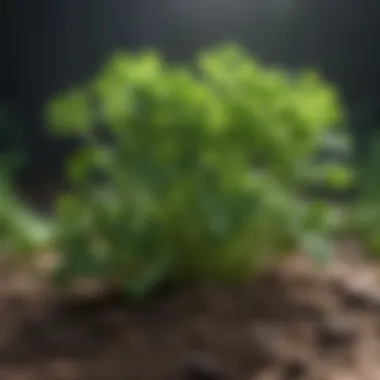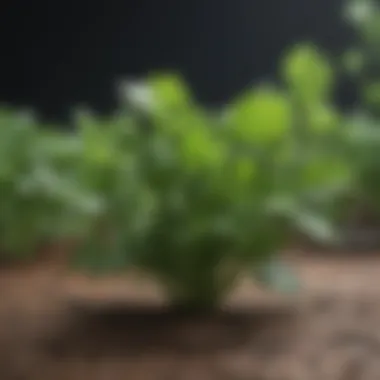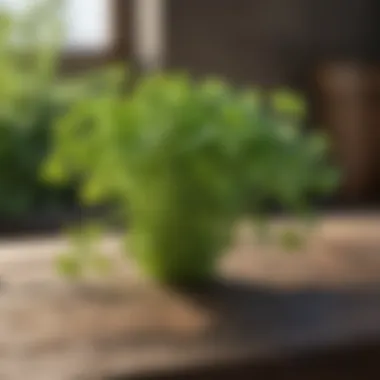Harvesting Cilantro: Techniques for Healthy Growth


Intro
Cilantro, also known as coriander in some parts of the world, is cherished not just for its vibrant flavor but also for its notable versatility in dishes. As many home gardeners discover, this aromatic herb can be a delightful addition to their culinary endeavors. However, harvesting cilantro properly is crucial, not just for immediate culinary benefits but also for sustaining the plant's health.
Understanding the nuances of when and how to harvest can maximize the yield while minimizing harm to the plant. This article will cover various techniques and best practices, ensuring that gardeners can enjoy cilantro throughout its growing season without depleting it.
Timing the Harvest
When it comes to harvesting cilantro, timing is everything. The ideal moment to snip off cilantro leaves is when the plant is approximately six inches tall. This size is often noted as a sign that the leaves are rich in flavor and nutrients. Delay harvesting too long, and the plant may bolt—turning its energy to flowering instead of leaf production.
Key Points:
- Harvest when the plant is six inches tall.
- Avoid harvesting after flowering begins, as it leads to bitterness.
- Regularly prune to encourage bushier growth and prolong the harvest.
Cutting Techniques
The method you use to harvest cilantro plays a vital role in keeping the plant healthy. Improper cutting can damage the roots or stress the plant, leading to a decline in overall health.
Best Practices:
- Use sharp scissors or garden shears to avoid squishing stems.
- Cut leaves from the top or outer parts of the plant, leaving the center intact to encourage further growth.
- Avoid cutting more than a third of the plant at once to prevent shock.
"By making thoughtful cuts, you're not just taking from the plant, but nurturing its ability to thrive continually."
Aftercare Procedures
The work doesn’t stop at cutting. Post-harvest care is equally important. After a good trimming, give attention to the remaining plant.
Aftercare Tips:
- Water the plant generously after harvesting. This helps it recover from the stress.
- Mulch around the base, as it retains moisture and suppresses weeds.
- Keep an eye on pests; remove any that might harm the tender leaves or disturb growth.
Balancing Utilization and Sustainability
It’s essential to strike a balance between enjoying your cilantro harvest and ensuring the plant remains healthy for future harvests. Many gardeners may be tempted to take too much at once, but patience and moderation will yield more rewards in the long run.
Sonic Recommendations
- Regularly observe plant growth. Adjust your harvesting technique based on how quickly the plant recovers after each cut.
- Rotate harvesting locations on the plant to support robust growth.
The End
Harvesting cilantro requires a blend of technique and timing. By understanding when to cut, how to do it correctly, and how to care for the plant after harvesting, you can maintain its health while enjoying its aromatic leaves. This balance between utilization and sustainability not only enhances your meals but also enriches the gardening experience, making it a worthwhile endeavor for every cilantro lover.
Understanding Cilantro as a Plant
Cilantro, often used in various cuisines around the globe, is more than just a flavorful herb. Understanding cilantro as a plant is crucial when it comes to ensuring that it thrives and provides a steady supply of fresh leaves for culinary purposes. This section will delve into cilantro's botanical characteristics and its growth lifecycle. Awareness of these factors not only plays a role in effective harvesting but also contributes to overall plant health.
Cilantro's Botanical Profile


Cilantro, or Coriandrum sativum, is an annual herb belonging to the Apiaceae family. Its distinct aroma and taste can be polarizing, with many loving its freshness, while others find it not to their liking. Botanically, it grows to about 20 to 30 inches tall, featuring feathery green leaves and small, white flowers. The plant is capable of reaching maturity in as little as three weeks under optimal conditions.
One of the remarkable aspects of cilantro is its versatility. Both the leaves and seeds (known as coriander) are used in culinary applications. The leaves are commonly harvested for salads, soups, and garnishes, while the seeds are harvested for their spice. Biodiversity in plants is like a treasure chest—each plant carries genetic material that can lead to a variety of flavors and aromas.
Growth Stages of Cilantro
Understanding cilantro's growth stages is a key element in managing its health and ensuring successful harvests. The life cycle of cilantro spans several stages:
- Germination: It begins with seeds being sown in well-drained soil. Within about a week, tiny sprouts peek above the ground. This is the time to ensure they are receiving proper sunlight and water.
- Seedling Stage: Following germination, the seedlings establish roots and leaf development accelerates. It is advisable to thin seedlings during this stage, allowing the strongest plants to prosper. If left overcrowded, plants can suffer from stunted growth due to competition.
- Vegetative Phase: As cilantro continues to grow, the leaves become more pronounced. This phase is vital for maximizing the leaf yield. Consistent watering and occasional fertilization can enhance growth during this time.
- Flowering and Bolting: Eventually, cilantro will bolt, meaning it transitions to the flowering stage. This can occur prematurely if exposed to extreme heat or drought. Although the flowers are attractive and attract pollinators, harvesting should ideally take place before this stage to preserve leaf quality.
By comprehending these growth stages, gardeners can tailor their care routines, ensuring that cilantro plants not only flourish but offer bountiful harvests throughout their lifecycle. Understanding these elements is like having a roadmap in navigating the journey of cultivating cilantro, making the process smoother and more rewarding.
The Importance of Proper Harvesting Techniques
When it comes to harvesting cilantro, adopting the right techniques holds immense significance. These methods can not only shape the quality and flavor of the herb but also influence its vitality in your garden. Improper harvesting can lead to stress that jeopardizes growth or even leads to plant demise. Understanding the essentials allows gardeners to maximize yield while being mindful of the plant’s health.
Impact of Harvesting on Plant Longevity
Every time cilantro is harvested, it endures a minor shock. This is especially true for young plants. The act of cutting can impact the overall vigor of the cilantro, affecting how quickly and robustly it continues to grow. Harvesting leaves too aggressively or at the wrong time may delay new growth, limiting the plant's ability to thrive.
Research shows that repeated harvesting encourages branching, leading to bushier plants. Yet, if the leaves are removed without care, the roots might not have enough energy to support continued development. Therefore, it's crucial to know how much to cut at once. A good rule of thumb is to harvest about one-third of the plant at any given time, allowing ample room for recovery.
Balancing Harvest and Plant Health
Striking a balance between getting your cilantro for cooking and ensuring it stays healthy can feel like walking a tightrope. Harvesting should be done thoughtfully. For instance, routine clipping encourages more growth; however, if done excessively, the results could be counterproductive.
Another consideration is timing. Harvesting the leaves when they are young and tender not only enhances flavor but also minimizes stress on the plant. Regular small harvests instead of a single big cut often yields more beneficial results. Consider the following points when harvesting:
- Watch for size: The leaves should ideally be 6 inches tall before cutting.
- Harvest during cooler hours: Early morning or late afternoon is best, as plants are less stressed.
- Observe plant health: Ensure the cilantro appears vibrant and free from wilting before taking any leaves.
Understanding proper harvesting techniques not only secures a better yield, it also maintains the lifecycle of your cilantro plants.
Through developing a keen awareness of timing and methodology, gardeners can engage with their cilantro in a sustainable manner, contributing to both personal satisfaction and long-term plant vitality.
Identifying the Right Time to Harvest Cilantro
Knowing when to gather your cilantro is like hitting a sweet spot; it greatly influences the flavor and health of your plants. If you don’t pay attention to timing, you might end up with wilted leaves or, worse, an exhausted plant that struggles to thrive. This section delves into understanding the vital signs of maturity in cilantro and how you can hit the timing nail on the head for a bountiful harvest.
Signs of Maturity
Determining whether your cilantro is ripe for picking can be a matter of keen observation.
- Leaf Size and Color: Mature cilantro typically boasts lush, vibrant green leaves that are larger than younger ones. The ideal time is when the leaves are fully developed but not yet turning yellow or wilting.
- Height and Stem: When your cilantro reaches about six to ten inches in height, it's generally a good signal that it’s ready. Check the stem; if it’s sturdy and upright, you’re likely on the right track.
- Flowering Stages: Flowering marks maturity, but it also indicates the plant is shifting energy away from leaf production. If you see buds forming, it's a sign that you should probably harvest soon to ensure flavorful leaves.
- Taste Test: Nothing beats a good old taste test. Snip a little leaf to check for flavor; if it’s robust and fragrant, you’re on time.
Making the call on when to harvest does not come without experience.
"Timing is everything in gardening. Get it right, and your plants will reward you countless times."
Best Practices for Timing
Harvesting cilantro is part art and part science. General guidelines can help shape your approach to timing:


- Early Morning Gather: The best time to harvest cilantro is in the early morning after the dew has dried but before the sun hits its peak. Cool temperatures make the leaves crisp and full of flavor.
- Regular Check-Ups: Keep an eye on your cilantro plants. If you allow them to grow too long without checks, they may bolt, meaning they will produce flowers and seeds at the cost of quality leaves.
- Continuous Harvest: Rather than harvesting all at once, take a few leaves here and there. This method allows the plant to regenerate, giving you steady produce over time without harming its growth.
- Observe Seasonal Conditions: The weather also plays a role. Hot summers can hasten the bolting process, so be on alert in such conditions.
By understanding when your cilantro is at its peak, you not only ensure flavor but also promote continued growth for future harvests.
Techniques for Harvesting Cilantro
Cilantro is not just a simple herb; it has a life of its own, and understanding how to harvest it properly can create a positive ripple effect on its overall vitality. The techniques used during harvesting can influence plant growth and yield, thus playing an essential role in the long-term maintenance of cilantro in your garden. When you adopt the right methods, you not only enjoy fresh cilantro but also contribute to the sustainability of your gardening efforts.
Harvesting cilantro effectively involves a combination of manual techniques and tool usage, which, if executed with care, ensures the plant continues to thrive. Let’s dive into the intricate details of these techniques.
Manual Cutting Methods
Cutting cilantro manually might seem like a straightforward task, however, doing it incorrectly can result in added stress on the plant. One of the fundamental approaches involves pinching off the cilantro stems close to the base rather than uprooting the plant entirely. This method is critical for promoting new growth. When done right, it provides access to the tender leaves and stems while allowing the cilantro to regrow quickly.
Moreover, it's vital to avoid cutting too close to the root. If you snip the plant down too much, you risk damaging the root system, which can impair future growth. Instead, aim for roughly one to two inches above the ground. This ensures the plant has enough foliage left to sustain itself while allowing for future harvests.
Using Tools Effectively
Scissors and Shears
When it comes to cutting cilantro, using the right tools can make all the difference. Scissors and shears are the go-to options for many gardeners. They provide precise cuts that are essential for keeping the plant healthy. The primary advantage of using these tools is their ability to create clean cuts, reducing the likelihood of damaging surrounding stems.
The specific design of scissors allows for easy maneuvering, particularly in tighter spots. This is a handy characteristic when dealing with dense cilantro patches. However, one must be careful, as dull blades can crush the stems instead of cutting them, which can invite disease. Remember, sharp tools equal healthy plants.
Accurate Knife Cuts
Another effective method involves using a sharp knife for harvesting cilantro. This technique is beneficial for those who need to cut a larger quantity quickly. When done correctly, an accurate knife cut allows the gardener to remove substantial clumps without excessive damage to the other growing leaves. The most significant feature of knife usage is the smoothness of the cut, which helps to minimize plant trauma.
On the downside, not everyone feels comfortable using a knife. It requires a bit of skill to ensure that you don't cut too deep or miss other stems while trying to make a clean slice. Therefore, careful handling and practice might be needed, but the results typically justify the effort.
Avoiding Damage to the Root System
It's imperative to prioritize the health of the root system during any harvesting process. Every time you cut cilantro, you are impacting its ability to regenerate. Preventing root system damage should be at the forefront of every gardener's mind. This means lifting plants gently if uprooting is necessary and always avoiding cutting roots inadvertently.
Additionally, one must be observant of how many leaves are cut away at once. Over-harvesting within a short period can significantly weaken cilantro plants. Take your time, harvest smartly, and ensure you leave enough foliage for further growth.
In summary, learning to harvest cilantro effectively is not just about the immediate enjoyment of its aroma and flavor in your dishes. Those techniques underscore a gardener's intent to nurture and sustain. Healthy harvesting is an act of thoughtful cultivation and respect for the lifecycle of plants.
Post-Harvest Care for Cilantro Plants
Post-harvest care of cilantro plants is like giving them a breath of fresh air after a long race. They’ve done their part by providing flavorful leaves, and now it’s time to boost their recovery, ensuring they remain robust and fruitful. Understanding what your cilantro plants need after harvesting is crucial for maintaining their overall health and maximizing future yields.
Nutritional Needs After Harvesting
Once you've snipped away a good bunch of cilantro, it's important to consider its nutritional needs. Like any living being, your plants need nourishment to bounce back. A balanced understanding of their requirements will aid recovery.
- Fertilizers: Consider applying a diluted liquid fertilizer that contains essential nutrients. Products rich in nitrogen are particularly effective as they promote lush leaf growth. Liquid kelp or fish emulsion can work wonders, providing a kick of nutrients directly to the root system.
- Organic Matter: Occasionally, you might want to add a layer of compost around the base of your cilantro plants. Compost not only enriches the soil but also improves its moisture-retention capabilities.
- Micronutrients: Don’t overlook the small stuff! Micronutrients such as magnesium and iron may also be essential depending on your soil quality. A soil test could guide you on what's lacking.
Fertilizing post-harvest helps to replenish what was taken away during the earlier harvesting stages. If you neglect these steps, you risk compromising the plant's future growth, resulting in fewer, less flavorful leaves in your next harvest.


Watering and Sunlight Considerations
Watering and sunlight play pivotal roles in the health of cilantro plants after harvesting. Just like humans need rest and proper hydration after working hard, so too do these leafy greens.
- Watering: After you harvest, it's crucial to keep the soil consistently moist, but not soggy. Water the plants gently, taking care not to wash away any newly applied fertilizers or disturb the roots. Early morning watering is ideal, allowing the plants to absorb moisture throughout the day. If the weather is particularly warm, check the soil frequently, as cilantro may need an extra drink if the sun scorches brightly.
- Sunlight: Cilantro generally prefers full sun but can also benefit from some shade, especially during the hottest parts of the day. If you recently harvested a large amount, consider providing shade cloth or nearby plants to protect them. You want to prevent the plant from bolting too soon, which can happen when they experience stress from excess heat.
In summary, keep an eye on both water levels and sunlight exposure following harvesting. This is a delicate balance, but it's key to nurturing cilantro back into a thriving state.
"Post-harvest care isn’t just maintenance; it’s an investment in the health of your cilantro for future harvests.”
Taking these simple steps not only facilitates a quick recovery for the plant but often results in better flavor in the long run. Keeping your cilantro healthy post-harvest is a foundational element of sustainable gardening that flourishes throughout future seasons.
Common Mistakes to Avoid When Harvesting Cilantro
Harvesting cilantro might seem like as easy as pie, but it’s a tad more complicated than just snipping some leaves. Understanding common pitfalls is crucial for maintaining the plant's health and ensuring a bountiful supply for future use. Ignoring careful techniques can lead to not just a less than ideal harvest, but also a struggling plant that may not survive long enough to provide you with flavorful cilantro in the future. Let’s take a closer look at what to avoid when tending to this delicate herb.
Overharvesting and Its Consequences
Overharvesting can be a big no-no in gardening, particularly with cilantro. When you take too many leaves at once, you risk shocking the plant and ultimately stunting its growth. It's a bit like trying to eat an entire cake in one sitting—while it seems delightful at the moment, there are consequences down the line.
Cilantro has a limit to how much foliage it can lose at any given time. If you find yourself harvesting more than one-third of the plant at once, you may face several setbacks:
- Reduced Growth Rate: By removing too many leaves, you're essentially taking away the plant's ability to photosynthesize efficiently. The more leaves you harvest, the less energy the plant can gather.
- Stress and Vulnerability: A heavily pruned plant may become susceptible to diseases and pests. It can be a tough world out there for our little green friends, and stress makes them more vulnerable.
- Flavor and Quality Issues: While you might be aiming for a hearty harvest, taking too much can make the remaining leaves less flavorful.
To avoid overharvesting, keep a close eye on the plant’s growth and only take what you need. A good rule of thumb is to clip about one-third of the leaves at a time and leave enough foliage to maintain the plant's health.
Ignoring Plant Symptoms Post-Harvest
After the harvest, it’s easy to forget about the cilantro plant itself, but it still needs care. Ignoring signs of distress in pain after a cutting session can lead to serious consequences down the road. Just as you wouldn't ignore a new cough or headache, keeping an eye on your cilantro post-harvest is essential.
Some signs that your cilantro needs attention include:
- Wilting Leaves: If your plant's leaves start wilting, it can signal either lack of water or too much sun. This can occur if the plant is overexposed after a significant pruning.
- Yellowing Foliage: Yellow leaves often indicate nutrient deficiency or that the plant may be overly stressed. Nutrient absorption is vital, so keeping the soil rich is a must.
- Slow Growth: If you notice your cilantro isn't sprouting new leaves as it should, it may be struggling to recover from the recent harvest. Watch for signs like stagnant growth.
Responding quickly to these symptoms can make or break the continued health of your cilantro plant. Consider adjustments in watering and sunlight exposure, as well as replenishing nutrients in the soil.
Culmination: Sustainable Harvesting for Future Growth
In the journey of cultivating cilantro, one critical aspect often overlooked is the importance of sustainable harvesting. This practice not only guarantees a continuous supply of this flavorful herb but also nurtures the overall health of the plant. When approached with care and consideration, harvesting cilantro can be a gratifying experience, ensuring future growth while also meeting immediate culinary needs.
Summary of Best Practices
To harvest cilantro effectively, keep the following best practices in mind:
- Harvest During Optimal Growth Periods: Cilantro thrives best when harvested during the cooler parts of the day, typically in the early morning or late afternoon. This minimizes wilting and maximizes flavor.
- Cut, Don’t Pluck: Utilize sharp scissors or shears to cut the stems just above a leaf node. This encourages the plant to grow back healthier instead of damaging the root system.
- Limit Quantity: Avoid taking more than one-third of the plant at a time. This helps maintain sufficient foliage for photosynthesis, supporting the plant's recovery and regrowth.
- Observe the Plant’s Signs: Understanding the plant's health is paramount. Keep an eye out for yellowing leaves or slow growth and adjust your harvesting techniques accordingly.
By incorporating these best practices, gardeners can ensure that their cilantro continues to flourish season after season.
Long-Term Benefits of Thoughtful Harvesting
Engaging in thoughtful harvesting practices offers numerous long-term benefits:
- Sustained Yield: By allowing the plant enough time to regrow between harvests, you create a cycle of continual yield. This means you're not just relying on a single crop but fostering an environment for ongoing production.
- Enhances Flavor Profile: Regularly harvesting in the right manner can enhance the flavor of the remaining leaves. As the plant grows in health, so too does the richness of its flavor.
- Supports Biodiversity: Maintaining healthy cilantro plants contributes to the local ecosystem. They can attract beneficial insects, which aid in pollination and natural pest control, fostering a more balanced garden.
"A little care goes a long way—sustainable practices today can yield fruitful harvests tomorrow."
Ultimately, the practice of sustainable harvesting serves not only immediate culinary needs but also fosters a resilient and vibrant cilantro garden. As gardeners and lovers of fresh herbs, the responsibility lies in fostering both the flavor and longevity of cilantro, making every cut count toward a brighter, greener growing future.







